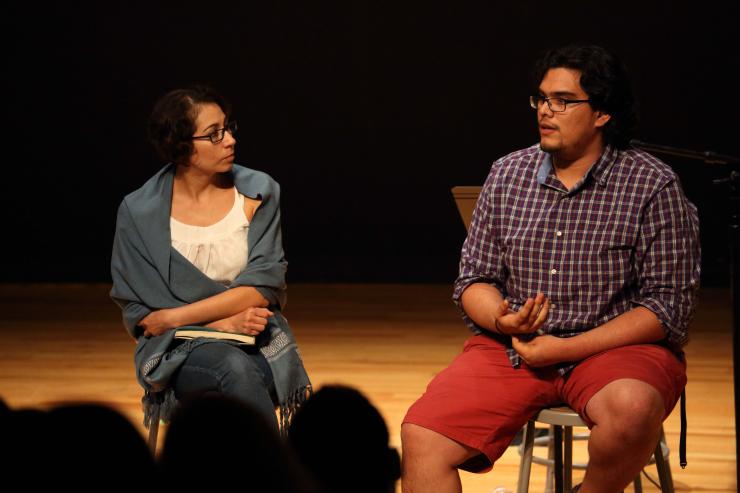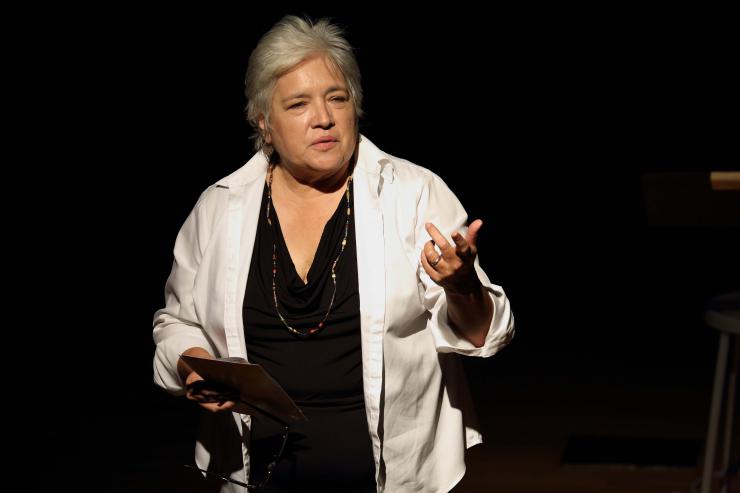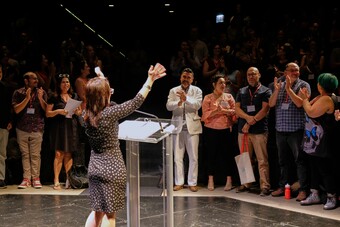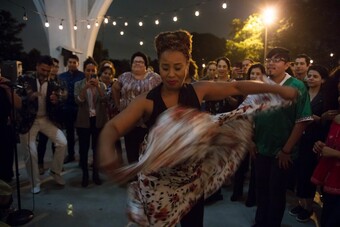Reflections on 5th Annual Austin Latino New Play Festival
The 5th Annual Austin Latino New Play Festival took place May 14-16 and was produced by Teatro Vivo in collaboration with ScriptWorks. The festival consisted of three staged readings immediately followed by brief question and answer/reflection sessions. This year’s plays were Basilica or The One with the Roosters by Andrew Valdez, La Carpa Garcia by Adriana Garcia, and The Stories of Us by Jelisa Robinson. These new pieces are still in development and in the middle of revisions. Though these playwrights are at the beginning of their careers, the works exhibited levels of maturity and complexity usually associated with seasoned writers.
The three plays that debuted at the festival were all quite different from one another, at least on the surface. The first play was Valdez’s Basilica or The One with the Roosters. This play told the story of a Mexican family that hoped to migrate to the United States in hopes of pursuing the “American Dream,” and the hardships they encountered along the journey at the hands of Los Zetas. This piece was loosely based on the Portuguese legend of the “Galo de Barcelos,” and blended elements that were reminiscent of Johann Wolfgang von Goethe’s Faust. The second script presented at this festival was La Carpa Garcia, which was based on the playwright’s family history and her grandfather’s experience in the family circus. This piece combined elements of oral history and verbatim theatre. The final piece, which debuted on the last day of the festival, was The Stories of Us. Robinson’s play dealt with the complexity of a multi-tier cultural identity. This playwright used a more thematic approach to communicate the complexity of the Afrolatinidad experience through the usage of vignettes.

Though these playwrights are at the beginning of their careers, the works exhibited levels of maturity and complexity usually associated with seasoned writers.
Even though the three selected plays for this year’s festival were very different in subject matter, I noticed a couple of trends. All three pieces were about either the Mexican or the Mexican American experience. In Basilica, the primary characters are Mexicans fleeing their motherland to pursue their fortune in the US. In La Carpa Garcia, the protagonist, Don Fito, is of Mexican descent and recounts his experience in west San Antonio, Texas, which has historically been a predominately Mexican/Mexican American community. In The Stories of Us, the Afrolatino/as reference their connection to Mexico. I find it interesting that all three selected pieces recounted the stories of the Mexican or Mexican American experience, but this makes sense, since there is large portion of Texas’s population that self-identifies with this label due to the state’s history and proximity to Mexico.
None of the plays were primarily written in Spanish, but each piece used the language to place the stories in a larger cultural context. The code-switching demonstrated in all three pieces allowed audiences to enjoy and understand the messages being communicated without marginalizing individuals who only spoke English. All three pieces did an excellent job switching from one language to the next without disrupting the natural flow of dialogue.
Another commonality I noticed in Valdez’s, Garcia’s, and Robinson’s work pertains to cast size and makeup. The casts necessary to perform these pieces might strike some as a challenge. Valdez’s work requires six actors, two of which are children. Garcia’s work requires twelve players, with all the actors playing multiple roles. Robinson’s work also requires quite a few actors—at least seven—and these actors also are required to play multiple roles. Larger casts also allow companies to showcase more talent from our community.

The last similarity I noticed pertains to the structure of the plays. None of them followed a linear trajectory. The plot of Basilica transcends the time and space by interspersing moments happening in reality and dream-like sequences. Valdez used scene breaks to transition between reality and dream sequences. As an audience member, it was a little hard to distinguish between reality and the dream sequences, but this is a problem that a director in a full production should be able to solve easily. In La Carpa Garcia, Garcia used flashbacks to tell her grandfather’s stories under the big top. She seamlessly intertwined the actions of the present with the stories of the past. She did not use scene breaks to disrupt the time-space continuum. Robinson’s The Stories of Us was episodic and used vignettes that were not necessary related to one another via the reoccurrence of the same characters but were related by the unfolding of the same theme: the complexity of identity.
After leaving this year’s festival, I am very excited about what these new playwrights will contribute to Latina/o theatre scene. The future looks bright and exciting and with time and experience these three new playwrights will continue to grow and mature in their craft.










Comments
The article is just the start of the conversation—we want to know what you think about this subject, too! HowlRound is a space for knowledge-sharing, and we welcome spirited, thoughtful, and on-topic dialogue. Find our full comments policy here